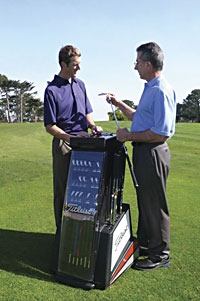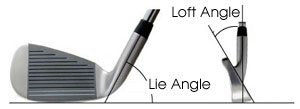 Through the years, the standard set of golf clubs has been designed for an average person, with average height, and average swings. But when you go to the driving range do you ever see an average person hitting balls? No…everyone is different. Some are tall. Some are short. Some are fast swingers. Some are slow. Some are pushing to the right. Some are pulling to the left. Some are even women.
Through the years, the standard set of golf clubs has been designed for an average person, with average height, and average swings. But when you go to the driving range do you ever see an average person hitting balls? No…everyone is different. Some are tall. Some are short. Some are fast swingers. Some are slow. Some are pushing to the right. Some are pulling to the left. Some are even women.
There’s probably as many “golfer types” as there are golfers.
In the last ten years technology has allowed golfers and golf equipment to be studied more closely. Launch monitors allow our swings to be analyzed in great detail. From these studies we’ve learned one thing in particular. Once size does not fit all. What works for one person with a 70 mph swing speed and a bad slice will not work for another person with a 110 mph swing and a hook.
How To Choose Golf Clubs and Fitting
There’s a dizzying array of choices when you go to buy golf clubs…everything from so called players clubs to the super game improvement clubs aimed at the novice golfer. But most off-the-rack golf clubs come in very standard lengths, lofts and lies. For shafts you may find only 3 or 4 flexes and types, all from the same shaft manufacturer. The choices are limited and not always right for you.
For example…even though club loft is a major component of accuracy, manufacturers have been making clubs with less and less loft over the years. Less loft will make the ball go farther but often at the expense of accuracy.
Why do they do it?
Because more distance is the big buzz in the industry. It’s not uncommon to hear someone say, “Boy my new irons are a club longer than my old ones.” That’s because his new 7 iron has the same loft of his old 6 iron. This does not help a golfer play better or enjoy the game more.
It’s also up to each golfer to understand their own games. Golfers should realize that just because Tiger Woods plays a certain club, that doesn’t mean that club will work for them. They need to accept their abilities and select equipment accordingly.
Tiger plays the clubs he uses because they fit HIM and his game. You should be looking for clubs that fit YOU and your game. That means you need a competent club fitting.
What Is ‘Golf Club Fitting’? 
Club fitting is adjusting clubs to your swing speed, height, arm length, hand size, swing shape and swing tempo. A good fitting measures all these parameters and then adjusts your clubs accordingly. Clubs can be adjusted for length, lie, shaft flex, shaft bend point, grip size, and swing weight.
Club fitting also means helping you choose clubheads with the right forgiveness and ball flight characteristics to fit your particular abilities. The correct adjustments will make a club easier to hit and maximize distance for you.
You can also select clubs that address a particular weakness in your game. Most golfers’ games usually need one of three things…more consistency, distance or accuracy. Sometimes they need all three. Your golf clubs can be adjusted to help in any or all of these areas.
 If you are a beginner or someone who plays very seldom, consistency may be an issue for you. Your lack of playing time makes center of clubface contact a little harder to maintain. Choosing clubheads that offer maximum forgiveness can really help you. Features like perimeter weighting, offset hosels, oversizing, low-back center of gravity and wide soles can meen a clubhead that has a larger sweetspot, higher ball flight and less of a tendency to twist on mishits. It can all add up to straighter, higher shots and more forgiveness.
If you are a beginner or someone who plays very seldom, consistency may be an issue for you. Your lack of playing time makes center of clubface contact a little harder to maintain. Choosing clubheads that offer maximum forgiveness can really help you. Features like perimeter weighting, offset hosels, oversizing, low-back center of gravity and wide soles can meen a clubhead that has a larger sweetspot, higher ball flight and less of a tendency to twist on mishits. It can all add up to straighter, higher shots and more forgiveness.
For someone who needs more accuracy, particularly with their driver, a shorter club with more loft may be the answer. More loft creates more back spin which means the side spin that causes the ball to curve will be less of a factor. The shorter length will help create more center-of-the-club-face contact which will also make the ball go straighter…and as a side benefit a bit farther.
If what you really require is more distance, then shaft flex, swing weight and driver loft become important. For example…suppose your club head speed is between 80-90 mph… close to the average for most male golfers and better female golfers. For that swing speed your driver should hit the ball about 200 yards in the air. The best shaft flex for that speed would be a regular flex shaft. However tests have proven that getting the ball to stay in the air as long as possible creates the most distance. The ideal launch angle to make that happen would be about 13 degrees. That translates to a driver loft of about 11 or 12 degrees. The result would be about 5 or 6 yards of additional carry distance.
It’s even more important for slower swing speeds. For a club head speed of 60-70 mph, typical of seniors, women and juniors, the potential carry distance is around 150 yards. The correct launch angle is more like 18 degrees. So a driver loft of 13-15 degrees is optimal. This can increase distance as much as 15 yards for these swing speeds…a big difference.
The point is, what we don’t know about golf club fitting can hurt our games. Understanding the important club fitting variables and what they mean can only help us be better golfers. And isn’t that what we all want?

